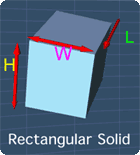
How to Find the Volume of Solids - The Basics
Lesson Objective
This lesson is an introduction to the basic
ideas on how to find the volume of solids.
We will be using a
rectangular solid and a cylinder as examples.
About This Lesson
After familiarizing with surface area, it is time to learn
about the volume of solids.
As an introduction, we will be learning on how
to find the volume of the following solids:
The study tips and math video below will explain more.
- Rectangular Solid
- Cylinder
The study tips and math video below will explain more.
Tip #1 - Rectangular Solid
To find the volume (V) of a rectangular solid, we just need to multiply the
width (W), length (L) and height (H)
of the solid together as shown below:
 The math video below will explain this
further...
The math video below will explain this
further...
V = WLH

Tip #2 - Cylinder
Now, to find the volume (V) of a cylinder, you just need to multiply
the area of the base (πR2) with the height (H)
together. This formula is shown below:
 The symbol, π, is just a
number that is approximately equals to 22/7 or 3.142.
The symbol, π, is just a
number that is approximately equals to 22/7 or 3.142.
The math video below will explain this further...
V = πR2H

The math video below will explain this further...
Tip #3 - Unit for Volume
It is important to get the unit for volume
correctly.
Here are some pointers:
-
First, make sure all the units are the same
Let's say that the width, length and height of a rectangular solid are given as follow:
Width (W) = 20mm Length (L) = 5cm Height (H) = 3cm -
Next,
understand what unit3 (cubic
unit)
means
Now, after ensuring the units are the same, we can calculate the volume, V below:V = WLH
Notice the cm3 (cubic centimeter) above? This 'cubic' comes about because we multiplied 3 lengths that are in cm. If W, L and H are in feet (ft), the unit for volume will be ft3 (cubic feet). Generally speaking, unit3 is the unit for volume where the unit can be mm, cm, m, feet, km, miles etc.
= 2×5×3
= 30 cm3
The math video below will explain this further...
Notice that the width has a different unit compared to the length and height? Now, we have to make these units the same by either changing them all to mm or cm.
Since 10mm is equals to 1cm, 20mm must be equals to 2cm. Hence, we have:
| Width (W) | = 2cm |
| Length (L) | = 5cm |
| Height (H) | = 3cm |
We can now calculate the volume since the units are now the same.
Math Video Transcript
Multiple Choice Questions (MCQ)
Now, let's try some MCQ questions to understand
this lesson better.
You can start by going through the series of questions on how to find the volume of solids or pick your choice of question below.
You can start by going through the series of questions on how to find the volume of solids or pick your choice of question below.
- Question 1 on how to find the volume of a rectangular solid
- Question 2 on how to find the volume of a cylinder